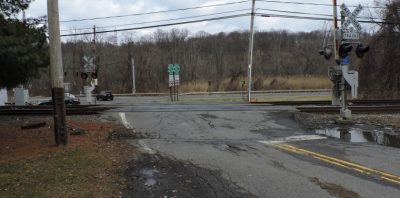Valhalla Train Crash Widower Still Pressing for Safety Upgrades
The widower of the SUV driver killed in the horrific 2015 Metro-North crash in Valhalla charged that the public remains imperiled at problematic grade crossings in the region despite the MTA claiming improvements have been made.
Alan Brody, whose wife Ellen, 49, operated the vehicle that was hit at the Commerce Street crossing on Feb. 3, 2015, said last week that safety enhancements at most of the danger areas are superficial and fail to address those drivers who may be unfamiliar with the quirks of a particular area.
The July 2017 National Transportation Safety Board (NTSB) final report on the accident didn’t find a precise reason for why Ellen Brody moved forward into the path of a train when the crossing arm was down, but suggested that a detour, heavy rush hour traffic and being in an area where she was unfamiliar probably played some role in her confusion.
Five passengers aboard the Harlem line train were also killed when the third rail was dislodged from the train’s emergency brake being applied, which sparked a fire in the front car.
“Basically, they need to bring the crossings up to the point where a modern-day driver who is not familiar with crossings or is not using them all the time sees that it’s not just a highway problem, but a severe highway problem,” said Brody, who lived in Edgemont at the time of the accident.
Last week, at about the time of the eighth anniversary of the tragedy, an online petition was launched calling for safety improvements at the Commerce Street crossing. There were more than 200 signatures by late Monday. The goal, Brody said, is to spur Gov. Kathy Hochul, state legislators and the MTA to make the necessary improvements.
Brody said there must be implementation of technology that forces trains to slow down or stop if there is anything on the track; improved lighting, including strobe lighting; improved signage, particularly the addition of standard highway signage instead of historical railroad signage, which can be confusing to today’s drivers; and the installation of bollards in the median at all crossings to clearly signal to drivers that they can’t go around the gates at a railroad crossings.
MTA spokesman Eugene Resnick said last Friday that an outside contractor was retained by the MTA to evaluate railroad crossings and recommend improvements, many of which have been or are implemented and that it has developed a partnership with Waze to alert motorists of the locations of railroad crossings to ensure visibility even in poor weather conditions.

“Railroad crossing safety is enhanced across the MTA network by gates, flashing lights and train horns, among many other preventative measures,” Resnick said. “All incidents are taken seriously and each has its own particular circumstances that are fully investigated.”
In December, U.S. Sen. Chuck Schumer announced that he was bringing more than $100 million to help Metro-North Railroad to improve safety at crossings in Westchester, Putnam and Dutchess counties. That money will include an estimated $67 million for an overpass over the tracks at Roaring Brook Road and the Saw Mill Parkway in Chappaqua.
Funding is expected for Positive Train Control implementation and improvements at other Metro-North crossings, Schumer said late last year.
Getting the state and MTA to make the needed improvement has proved to be a challenge, Brody said. Legislation sponsored by former assemblyman Tom Abinanti and ex-state senator David Carlucci that would have forced the MTA and state Department of Transportation to study each crossing, was evaded, he said.
A major lawsuit by Brody and other families against the MTA in connection with the 2015 crash is likely to move forward later this year.
Meanwhile, Brody’s mission is to make sure each crossing gets the safety improvements that are needed.
“So, basically, you need signage, improved signage, you need improved lighting, you need bollards to make sure that people understand the risk that’s coming,” Brody said. “You need things that bring it up to speed so somebody that uses the crossings infrequently, or never, understands what they’re getting into.”

Martin has more than 30 years experience covering local news in Westchester and Putnam counties, including a frequent focus on zoning and planning issues. He has been editor-in-chief of The Examiner since its inception in 2007. Read more from Martin’s editor-author bio here. Read Martin’s archived work here: https://www.theexaminernews.com/author/martin-wilbur2007/


